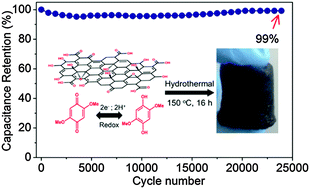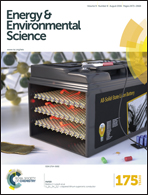Pseudocapacitance and excellent cyclability of 2,5-dimethoxy-1,4-benzoquinone on graphene†
Abstract
Electrochemically active organic materials are emerging as low cost, naturally abundant and sustainable alternatives to their metal-based counterparts. However, their usage in energy storage systems is mainly hindered by their poor conductivity, which results in capacitance fade upon cycling. Here, we report a redox-active xerogel composed of 2,5-dimethoxy-1,4-benzoquinone (DMQ) decorated on reduced graphene oxide (rGO) sheets via a hydrothermal method as a high capacitance and long cycle life pseudocapacitive electrode. DMQ not only provided stable redox-active centers but also served as a spacer to avoid rGO sheets aggregation and led to a three-dimensional (3D) hierarchical electrode architecture. When a binder-free 50 μm thick rolled film was tested as a pseudocapacitive electrode, it exhibited an excellent capacitance of 650 F g−1 at 5 mV s−1 (780 F cm−3) in 1 M sulfuric acid, outperforming a large number of reported organic and inorganic electrodes. Most importantly, optimized electrodes showed an excellent capacitance retention of 99% after 25 000 cycles at 50 mV s−1. Density functional theory (DFT) calculations are further used to understand the charge storage mechanism, the preferred orientation of the adsorbed molecules, charge density distribution and density of states. Our combined experimental and theoretical findings demonstrate that the careful selection of the conductive substrate, electrode architecture and organic molecules plays a crucial role in achieving high capacitance and long cycling performance.


 Please wait while we load your content...
Please wait while we load your content...